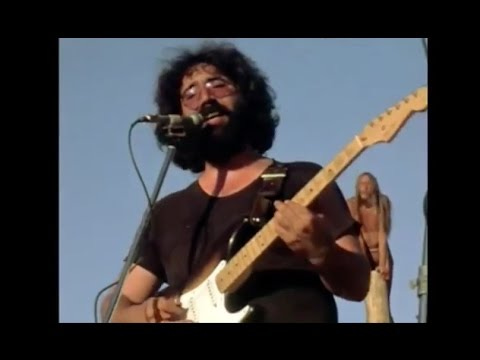Me? A Grateful Dead Fan?
Old music habits die hard, but at 46, rock 'n roll fan Aaron Gilbreath has found an antidote to pandemic malaise in the quintessential hippie band.
I grew up in the 1990s with a reflexive disdain for hippies. Two years into the COVID pandemic, at 46, I became a huge Grateful Dead fan.
After watching several music documentaries, my 41-year-old wife suggested the six-part Dead documentary A Long Strange Trip. That surprised me. She’s always loathed The Dead, too. In two marathon nights, we watched The Dead move from an underground acid experiment to the global cultural phenomenon we knew as kids, and as with good LSD, the effects didn’t end with that trip. Aside from music like the Encanto soundtrack, which our 4-year-old daughter requested, we jammed nothing but The Dead for eight straight days.
In two marathon nights, we watched The Dead move from an underground acid experiment to the global cultural phenomenon we knew as kids, and as with good LSD, the effects didn’t end with that trip.
On the first morning of this bender, I woke up humming The Dead’s “Birdsong” for the first time in my life. My wife blasted “Death Have No Mercy” on the kitchen speaker, and we wondered: What’s happening to us?
Our openness to The Dead went against the conventional grain of aging. Most people over 30 don’t search for new music. We do that in our teens and twenties. In fact, musical taste starts to set as early as age 14. As we age, we lose neuroplasticity, which makes it harder to decipher unfamiliar patterns in new music, and we crave familiarity, often familiar music that sparks nostalgia. It felt good to break that pattern.
Every morning it was the same: make breakfast while playing The Dead, and ready our daughter for preschool. At home, my wife and I worked to countess live versions of “Althea” in a row, and I found a five-hour instrumental jam sequence a Deadhead made on YouTube. Our adolescent rejection of The Dead dissolved. What was there to resist: Joy? Singing as a family? Some friends welcomed us to the tribe. Others wondered what had happened to the couple with great musical taste.
This transformation couldn’t have been more sudden or welcome.
Most people over 30 don’t search for new music. We do that in our teens and twenties…As we age, we lose neuroplasticity, which makes it harder to decipher unfamiliar patterns in new music, and we crave familiarity, often familiar music that sparks nostalgia.
As a textbook ’90s alternative rock kid, I was supposed to dislike hippies. I’d grown up skateboarding and living by the old motto “Skate and Destroy.” Hippies were all about smiling on your brother and trying to love one another right now. Nirvana mocked that very lyric in their song “Territorial Pissings,” on their 1991 album Nevermind, which I bought when it came out. I inherited the idea that hippies were these dirty, aimless barnacles who believed in outdated ’60s ideals that they were too lazy to help realize, because they spent all their time following The Dead, reframing their wasted selves with “Not All Who Wander Are Lost” bumper stickers, and spouting pseudo-scientific cosmic garbage at you, like how the cosmos takes care of the caring peoples’ needs because the cosmos knows who waters the Earth’s garden, which was something a hippie actually told me once, and I laughed. Kurt Cobain’s disdain reinforced my own. “I wouldn’t wear a tie-dyed t-shirt unless it was dyed with the urine of Phil Collins and the blood of Jerry Garcia,” Cobain said. Hippies symbolized our parents’ generation, so by embracing ’90s indie culture, we rejected the Baby Boomers’ failed utopia. Every generation builds their own thing by rejecting their parents’ things. Disdain became reflexive: Dumb hippies. That sounds hippie. What are you, a hippie?
That logically extended to The Dead.
In the early ’90s, my favorite music came from loud guitar bands. The Dead jammed. I didn’t jam. The fact is, underneath all this posturing, I’d never listened closely to the band’s huge musical catalog. All the shirtless, wiggling dancers who twirled to their music let me convince myself of that old joke: “What does a Deadhead say when the drugs wear off? ‘This music sucks.’” But no self-respecting adult can hate a band they’ve never really heard. During the winter of the omicron surge, in my mid-40s, I was twirling to their music in my kitchen.
“Seriously, this is the surest sign we have disintegrated at the end of the pandemic,” my wife speculated one morning. “There’s no clearer sign that I am not okay than that I want to become a fucking Deadhead—and there’s not even a band anymore!” She was right.
As a textbook ’90s alternative rock kid, I was supposed to dislike hippies. I’d grown up skateboarding and living by the old motto “Skate and Destroy.” Hippies were all about smiling on your brother and trying to love one another right now.
Like thousands of people this winter, we’d had our mood darkened and our family’s world shrunken by COVID’s omicron variant. To avoid infection, we stuck to preschool, public parks, grocery stores, and home. We tried to stay positive. We tried to live, but it was depressing. No big trips, no parties, no concerts—our poor 4-year-old daughter, who’s spent half her life, so far, in varying degrees of lockdown. Cold rainy winter weather made playing outdoors miserable, and doing everything at home was stifling. Days felt like tunnels: You moved from one end to the other, keeping the same predictable course. The Dead expanded our world and infused it with joy—not just in our minds, but in our bodies, too. Singing and dancing to their grooves, I was a happier, more relaxed person. I felt buoyant, lighter on my feet. It was like the music triggered a mushroom trip memory and brought all the neurological benefits without any of the drugs. Sixties kids used the term “afterglow” for the peaceful state that follows a psychedelic experience. We needed it, and we got it, from listening to our new favorite band.
After Long Strange Trip ended, we watched the documentary about their rhythm guitarist, The Other One: The Long, Strange Trip of Bob Weir. Lately, no matter what I was doing, Weir’s guitar pattern from “China Cat Sunflower” seemed to noodle through my mind, and Garcia’s nimble solo from “Franklin’s Tower” live in Nassau 1980 uplifted me. My wife and I texted each other live versions of songs with messages like “Good solos on this one.” At dinner we shared the day’s discoveries: “Have you heard Philly 1982? Veneta, Oregon ’72?” By day three, our daughter sang “Touch of Grey” with me.
My wife had a theory: The documentary and band offer the ideal antidote to pandemic life, because they present a world that we no longer inhabited.
In Long Strange Trip, the Deadheads swarmed each other at these big, sweaty gatherings, traveled freely, and got along. 2022 is so politically divisive. Everyone’s on a side, and each seems poised for battle. Anxiety and distrust have taken the place of community connections. But as writer Steve Silberman describes in Long Strange Trip, Dead shows were “a mandala with different regions” inhabited by different types of fans who came for different experiences, some spinning in religious ecstasy, some focusing on Phil Lesh’s baselines, some holding 12-step meetings during the breaks between sets. And they managed to give each other room to be themselves. Sure, the shows were flawed and unsustainable. Deadheads had tons of problems, but that whiff of utopia resonated with us. On screen was the world that we remembered from 2019, one characterized by big rock shows, mobility, and a carefree sensibility. Instead of loathing those naked hippies, now I loved them. Middle age opened us to all this. The cultural moment facilitated absorption. And love is what we need.
The Dead expanded our world and infused it with joy—not just in our minds, but in our bodies, too. Singing and dancing to their grooves, I was a happier, more relaxed person.
My wife always has excellent perspectives. Then there was the music.
The Dead played dark Blues and songs about death, but their upbeat, hypnotic songs like “Scarlett Begonias” and “Fire on the Mountain” improved my mood. I’ve been under so much stress lately, tensely living under constant deadlines and tight schedules and parental demands, and here comes this music that leaves me swirling in a circle, with my hands in the air, less battered by Earthly concerns. Walking the dog in the morning, hearing Jerry’s nimble solos induces the same relief I imagine I’d get from quitting my job, hitting the road, and never wearing shoes again. It’s like Fuck it, I’m free! While Weir and Jerry sing “Roll away the dew,” something rolls away from me. Then I walk back through our house’s front door to get ready for the workday and drive our daughter to school, feeling ready to try to smile on my brother and to love one another right now.
For me, the drugs wore off decades ago, and The Dead’s music still doesn’t suck. Their biographer Dennis McNally later called all the ancillary stuff like the Deadheads and concert parking lot parties “distractions.” That stuff definitely distracted me. Listening to the music as a secure, open-minded adult, I hear the songs on their own merits, and the band as the incredible musicians they are. To think how many years I’d been missing out!
Embracing The Dead in mid-life revealed a lot about myself philosophically, too—my old, stifling ideas, my blind spots, and how much I shared with the very same hippies I wanted to loathe. Even in the early 1990s, I ate natural foods, loved hiking, camping, psychedelics, and sleeping in cars on road trips, and I preferred to be shoeless. I still do. Despite my punk shell and penchant for skateboarding, I always contained more hippie than I was willing to admit. Hell, I drive a large camper van now, decorated with rainbow and cresting wave stickers. The pump was already primed.
Our Grateful Dead bender lasted eight days. As Deadheads know, the journey always ends. When Jerry Garcia died in 1995, fans had to find something else to do. Many went down the rabbit hole of the band’s live music archive, which is where my wife and I find ourselves now, jamming our antidote to pandemic gloom. Travel, community, a sense of positivity and freedom—The Dead offer many things the last two years denied us. It’s utopia. Like the Deadheads’ world, it’s also a fantasy that’ll end, but for now, it works.







Great essay. Glad the writer finally came to appreciate the Dead. Speaking as an "old hippie", who actually was at Woodstock 69, one of my favorite memories of that era was being in the audience of a Grateful Dead concert when Jerry Garcia announced from the stage that Nixon had resigned.
Everyone went crazy. Wish I could remember what song they played next.
Stumbled onto your blog looking for some Flaming Lips info. I've always been a casual fan, but currently going down the rabbit hole of their full catalog. That led me to this essay, and it sounds really familiar! I also "discovered" the Dead at the beginning of COVID, with the same documentary as my launching-off point. The "36 From the Vault" podcast really drove it home and now I'm seemingly hooked for life. I really enjoyed this one, and the entire Flaming Lips / Art School piece. Thanks!